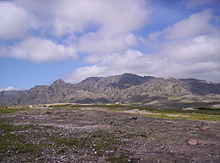| |||
| Cordoba Province | |||
| Capital | Cordoba | ||
|---|---|---|---|
| Residents | 3.567.654 (2015) | ||
| surface | 165,321 km² | ||
| website | www.cba.gov.ar | ||
| no tourist info on Wikidata: | |||
| location | |||
.svg/200px-Cordoba_in_Argentina_(+Falkland_hatched).svg.png) | |||
Cordoba is a province in the center Argentina. With more than 3 million inhabitants, it is the second largest in Argentina in terms of population.
Regions
- Sierras de Cordoba in the West
- Laguna Mar Chiquita and surroundings in the northeast
- Pampas in the south and southeast
places
- Cordoba, 1.4 million inhabitants, the capital and second largest city of Argentina. The colonial old town is a world heritage site.
- Río Cuarto, 150,000 inhabitants, in the south of the province.
- Villa Carlos Paz, 80,000 inhabitants, most famous tourist place
- Cosquín, Festival city that hosts the largest folklore festival in Argentina
- Villa General Belgrano, "alpine" enclave with a beefy "Oktoberfest"
Other goals
background


The “heart of Argentina” as Cordoba is often called, is a province of contrasts. From the wide pampa plains in the southeast over the hot Chaco savannah in the north (with the South American heat pole Villa de María) to lovely mountain landscapes and rough plateaus, the province also offers a lot for tourists. And then of course there is the capital with its colonial buildings, which are a UNESCO World Heritage Site.
Economically, the once rich province is now in the lower middle range of Argentina, with a gross national product that is 20% below the national average. Nevertheless, the infrastructure is well developed, especially in the sierras and the vicinity of the capital. But especially those who venture into the remote areas in the northwest of the province will get to know extreme poverty and hunger. The main economic sectors are industry in the provincial capital (especially automobile plants) as well as agriculture and food production, tourism only plays a local role, especially in the booming region of the Punilla Valley.
language
The Spanish of the province of Cordoba has a somewhat idiosyncratic accent, the tonada cordobesa. The penultimate syllable (in some cases also the third last) is stretched and stressed, and some consonants such as J and Y are pronounced similarly to Iberian Spanish.
getting there
There is an international airport in Cordoba. This is slowly recovering from the Argentina crisis, which was devastating for Argentine aviation, and is now offering flights to, for example Panama City at.
Good roads exist in all directions. To the west the Ruta Nacional 20, to the south the Ruta 36, to the east the Ruta 19 as well as the transverse axis from Buenos Aires via Córdoba to the northwest Ruta 9.
mobility
The busiest network is offered by the bus companies, which reach almost every corner of the province and travel between the main travel destinations at frequent intervals.
There are still two train routes: the Tren de las Sierras in the northwest, a delightful narrow-gauge line, and the Córdoba-Rosario-Buenos Aires.
Tourist Attractions
They are attractive, but unfortunately a bit shabby Buildings of the Jesuits the capital Cordoba and the middle city Alta Graciathat was laid out around a manor. These partly magnificent churches and monasteries share the space with modern high-rise buildings, especially in the capital itself.
In the cities of Sierras de Cordoba you can find idiosyncratic architectural styles such as the alpine style in Villa General Belgrano or the English country house style in La Cumbre.
activities
The sierras are ideal for hiking and other types of mountain sports or just swimming in mostly crystal clear rivers and waterfalls. The provincial capital also offers a wide range of cultural activities.
kitchen
Typical for Córdoba is the Arab-Argentine cuisine, especially the empanadas arabestriangular dumplings with minced meat, onion and lemon filling.
Furthermore, the production of alfajores, biscuits sprinkled with coconut flakes and filled with caramel cream (dulce de leche), typical of the sierras.
nightlife
While in the capital Córdoba there is hustle and bustle almost every day at night (except Monday and Tuesday) and you can also meet international DJs, the nightlife in the sierras is limited to the summer and winter months. There are "village discos" in every small town.
security
In terms of security, Córdoba is in the Argentine midfield. Attacks can occur in the outskirts of the provincial capital, but in the center you can move around freely at night. But it must also be said that the media often exaggerate the incidents a bit.
climate
The climate of Cordoba is subtropical to temperate. In the north of the province, the summers are extremely hot (this is where the South American heat pole is located, 40 ° C is not uncommon), while it is pleasantly cool, especially on the plateaus of the Sierras, even in midsummer. Several places have microclimates that are considered particularly healthy. The provincial capital Córdoba, on the other hand, should be avoided in summer, as it is not only hot, but also quite rainy and humid.
In winter it can snow in the mountains, but it is not enough for winter sports.
literature
Web links
- http://www.cba.gov.ar (it) - Official website of Cordoba



